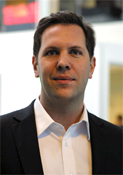
Martin Tall

 |
Note: Site not kept up to date
My research focuses on eye tracking which is a method for computers to estimate where someone is looking. I seek novel approaches to utilize this information in real-time, for example hands-free computer and robot control, or to define visual search of medical images. Visit my gaze interaction blog for more information on the topic. I'm also affiliated with the Gazegroup.org promoting affordable eye tracking solutions. Feel free to contact me if you are working on related projects. |

On August 15th the Eye Tribe was selected for the ScaleIT program, sponsored by the Danish Ministry of Export, to establish network and presence in Silicon Valley.
On August 18th the Eye Tribe raised funding from a group of European investors to fuel next-generation eye contol on post-pc devices.
On June 19th the Eye Tribe showcased the worlds first eye controlled Windows 8 tablet, see the demonstration video.
On June 6th the Eye Tribe completed the Accelerace program and won the audience award during the investor day.
On May 21st the Eye Tribe team participated in the European eHealth challenge and came out 1st.
On May 2nd I gave a talk on "Aquiring, analyzing and visualizing volumetric gaze data from Radiologists interpreting chest Computed Tomography" at the Scandinavian Workshop on Applied Eye Tracking kindly hosted by the St. Erik Eye Hospital at the Karolinska Institutet in Stockholm, Sweden. Proceedings available here.
On April 14th the Eye Tribe team participated in the Rice Buiness Competition, made it to the semi-finals and won the Most Disruptive Technology award.
On January 25th Senseye, thereafter renamed "The Eye Tribe", participated in the Venture Cup Idea competition and won the Product & Technology category.

On November 19th I went to Stockholm with the Eye Tribe team to participated in the Idea 2 Product Global competition, Sweden, where we won the ABB Global Innovation Award for best demo and 2nd place in the ICT category.
On September 8th The Eye Tribe joined the Startup Bootcamp accelerator program with a product called Eyeproof that enables large-scale eye tracking data collection and online browser-based analytics.
On September 1st I left Duke and relocated to Copenhagen to start an eye tracking company called The Eye Tribe.
On March 28th I visited the Harvard Visual Attention Lab and gave a presentation on "Eye Tracking and Observer Studies of Volumetric CT" at the Department of Radiology, Brigham & Women's Hospital.
On March 1st I officially joined the Department of Radiology at Duke University in North Carolina as a Senior Software Engineer to further develop the eye tracking research project started at Stanford in 2009.

On November 15th Auntminnie.com, a comprehensive online community for radiologists, published an interview titled "Visual search patterns of volumetric datasets may reveal much" in the pre-RSNA2010 conference highlights.
On October 27th, released the Gaze Tracker version 2.0b, the first open and accessible eye tracker that allows fast (+170Hz) and accurate (0.3-0.7 deg.) binocular tracking at the unprecedented low-cost. See the demonstration video or the setup.
On August 16th I relocated to Duke University in North Carolina to continue the research on eye tracking in Radiology along with Dr. Geoffrey Rubins new position as Chair of the Radiology Department at the Duke University Medical Center. The new eye tracking lab is located at the Ravin Advanced Imaging Laboratories headed by Dr. Ehsan Samei where related research by Dr. Georgia D. Tourassi is also taking place. Collaboration with Stanford is ongoing (new lab, same project).
On May 31st the Gaze Group released ITU Gaze Tracker 1.5 that fixes a number of issues reported by users in the forum.
On May 6th, the open source eye tracker I've been involved with since 2009 was awarded the Research Pearls of the IT University of Copenhagen.
On January 10th the Stanford research project was featured in the annual update for the Radiology department. The selected section highlights our research under the heading "Image Display and Analysis: 3D Lab". Download the 2009-2010 Annual Update (pdf, 1,2Mb)

On November 7th I gave a talk on "Mapping Eye Movements in Three-Dimensions: Analyzing Gaze Paths when Interpreting Volumetric Chest CT Data" at the Stanford Biomedical Computation Symposium 2009 (BCATS). The short 300 word abstract can be found in the proceedings.
On October 19th the initial results of the Gaze tracking in Radiology project at Stanford University was presented at the Medical Image Perception Society (MIPS). The talk concerned achievements on our Radiology specific platform as well as the research on lung nodule detection in the peripheral visual field while reading CT scans. A list of talks from the conference is found here. A pdf with the conference proceedings may be requested at the MIPS website.
On May 1st I started working at Stanford University as a Research Associate for the Department of Radiology. The research aims at investigating how medical doctors navigate and evaluate large volumetric datasets created by imaging modalities such as CT-scanners. Part of the research aims at developing the next generation workstations where eye gaze tracking might provide advantages and additional value. Pricipal investigators for the project is Professor Geoffrey Rubin, M.D. in conjunction with Professor Sandy Napel, Ph.D.. The intradisciplinary research group I am a part of houses David S. Paik, Ph.D, Justus Roos, M.D, Kingshuk Roy Choudhury, Ph.D, Tae-Jung Kim, M.D, Florian Schmitzberger, M.Sc and Danielle Rasooly. Additional collaboration with Donald L. Ly from University of Toronto, Canada, took place during the summer of 2009.
On April 6th the ITU open source platform for eye tracking and gaze interaction was presented at the CHI09 conference in Boston. During this event the software package was made available for public download including full source code. IDG News came by and did an interview with Javier San Agustin, who is the author of the eye tracking engine.
On March 31st the Danish Radio (DR1) broadcasted an interview for the ITU open source gaze interaction platform.

On November 21st our prototype for an eye movement controlled robot appeared on the nine o' clock Danish news (DR1 TV-Avisen). The prototype was developed in cooperation with Alexandre Alapetite, Ph.D at the Technical University of Denmark. Check out the videos.
On Septermber 2nd I presented parts of my Masters thesis at the Communication by Gaze Interaction (COGAIN) 2008 conference in Prague, Czech Republic. In addition, an early version of the EyeTube interface for eye movement control of YouTube through an advanced custom interface was presented. This software may now be downloaded here.
On August 1st I was awarded a fully funded three year PhD fellowship at the IT University of Copenhagen, Denmark, where I will be a part of the Gaze Group within the Innovative Communications department headed by Associate Professor John Paulin Hansen, Ph.D. An exciting opportunity to continue research and development of state-of-the-art gaze based computer interaction with focus on online social interaction and communication. The research will be supervised by Associate Professor Dan Witzner Hansen, Ph.D (site) who has considerable experience within eye tracking. Against better judgment heres the mission statement in the form of my application (pdf, 94kb).
On June 22nd I successfully defended my masters thesis on gaze interaction interfaces at the Cognitive Science dept. at Lund University, Sweden. Check out the video demonstration or download the thesis NeoVisus Gaze Interaction (PDF, 3.3 Mb)

Growing up in the souther parts of Sweden my youth was filled with adventures into the digital domain. From my mother I obtained a Sinclair ZX-81 and started programming at the age of nine. As a teenager I ran the Utopia BBS that connected computer users in the region. Around 1994 I got my first Internet connection and started making websites, which led to a number of projects and employments. In 2004 I enrolled with Lund University in Sweden for a degree in Informatics / Software design. In 2006-2007 I spent a year at the University of California, San Diego with a great opportunity to endeavor in Cognitive Science. The year made a huge impact. During this period I was introduced to various sensors for measuring human physiology where eye gaze tracking was the coolest thing I'd ever seen. Combined with the background in software, computers and cognitive science I pursued a Masters degree at Lund University with the ambition of building an eye movement controlled computer. I continued this path as a graduate student at the IT University of Copenhagen, during this period I was approched by a group of researchers at the Stanford University School of Medicine and took a one year leave from ITU in 2009. The Radiology project was extended in 2010 and moved to Duke University whereby the PhD in Copenhagen was discontinued.

